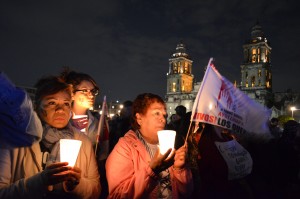 They lost the bet, those who counted on the movement fizzling out at the end of the year. The government failed in its attempt to bury the case. Efforts to cast the tragedy into the pit of oblivion came up against the persistance of collective memory and shared outrage.
They lost the bet, those who counted on the movement fizzling out at the end of the year. The government failed in its attempt to bury the case. Efforts to cast the tragedy into the pit of oblivion came up against the persistance of collective memory and shared outrage.
On January 26, for the eighth time since the fateful September 26, tens of thousands of people from various sectors marched through the streets of the capital with a two-pronged demand: to bring back alive the 43 disappeared students of Ayotzinapa and to transform national public life. Nothing less.
Four months after the crime against students of the Raul Isidro Burgos teaching college in Ayotzinapa, Guerrero, and given the lack of credible results of the investigation by the Mexican government, the movement maintains its capacity to mobilize people and this time managed to achieve a new level of coordination with social movements opposed to the regime of Enrique Peña Nieto.
The VIII Day of Global Action for Ayotzinapa and Mexico consisted of ten hours of marches from the four corners of Mexico City to the Zocalo, in addition to protest activities in more than 40 cities in the country and the world. In the first march of the year, which showed the failure of those who assumed that the December holidays would stop the momentum of the protests, the students’s parents called on all the families of the victims of enforced disappearances in the country to the joint the fight.
Mario Cesar, the father of Manuel who was among the disappeared, initiated the rally with a call for unity in the protests against enforced disappearance in Mexico:
“It’s amazing the pain you feel when you have a missing child. I encourage all parents who have lost sons or daughters to contact us, so we´re in communication, so they too raise their voices because we aeren’t the only ones… The bodies found in the clandestine graves also have faces, names, families who are entitled to know who these bodies belong to. To all those people, I invite you to join us so we can find a solution to this problem. ”
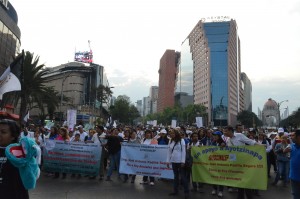 Several speakers invited the thousands of people present at the rally that closed the day, to the National People’s Convention to be held on Feb. 5 and 6 in Chilpancingo, Guerrero to build strength and create conditions for the installation of a new constitutional assembly. February 5 is the anniversary of the promulgation of the 1917 Mexican Constitution and a national holiday.
Several speakers invited the thousands of people present at the rally that closed the day, to the National People’s Convention to be held on Feb. 5 and 6 in Chilpancingo, Guerrero to build strength and create conditions for the installation of a new constitutional assembly. February 5 is the anniversary of the promulgation of the 1917 Mexican Constitution and a national holiday.
Parents of the college students, each carrying a poster of their missing son, marched alongside members of Section XVIII of the National Union of Education Workers (SNTE, by its Spanish initials), a member of the democratic current, the National Coalition of Education Workers (CNTE). They arrived at 10 a.m. at the Auditorium and set off for the Angel of Independence statue, where they joined the contingent of trade unions and peasant organizations. Together the march entered the capital’s central plaza, the Zocalo, at around 4.
By that time, two contingents–one from the southern transportation center of Taxqueña and one from Boulevard Ignacio Zaragoza and the northern transportation hub of Indios Verdes–had already arrived in the Zocalo.
The mobilization was a first rehearsal for broadening the movement to include the demands from other sectors, coupled with the main demand for presentation of the 43 missing. The national march that union rank and file and peasant organizations from the movement for food and energy sovereignty have held for more than a decade on the last working day of January was shifted this year to coincide with the global day of action Ayotzinapa.
The Mexican Electricians Union marched, fighting for the return to work of more than 15,000 of its union members who have held out for five years after the federal government eliminated their jobs; organizations of the National Peasant and Indigenous Convention, vying for comprehensive rural reform and the repeal of the energy reform that allows the occupation of their territories by oil and power companies. And a host of student organizations, unions, civil and social movements united by general repudiation of the dominant neoliberal model.
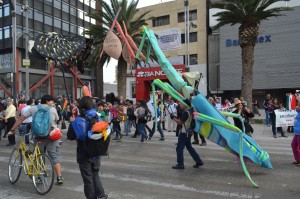 A huge praying mantis crafted in wood and cardboard by members of the Mexican Puppet Center bore the phrase “It was the state”. The phrase has become the slogan of protesters to refute the implausible official version of events the night of September 26 in Iguala, Guerrero. It has gained strength now lately with growing accusations that the Mexican army was also involved in the crimes.
A huge praying mantis crafted in wood and cardboard by members of the Mexican Puppet Center bore the phrase “It was the state”. The phrase has become the slogan of protesters to refute the implausible official version of events the night of September 26 in Iguala, Guerrero. It has gained strength now lately with growing accusations that the Mexican army was also involved in the crimes.
Omar Garcia, an Ayotzinapa student and survivor of the attacks, acknowledged the strength and determination of the parents who have continued to demand for more than 120 days that their sons be returned alive. He noted that the government still does not accept its direct participation in the events of September 26 in Iguala, and is doing everything possible to close the case without resolving it.
Government authorities have even sought to deny the forced disappearance of the students of the rural teachers’ school. “In the past few days, in their report on human rights released internationally, they don’t even touch on September 26, and keep talking about the disappeared before that date, although this problem has transcended borders and all Mexicans are talking about it,” he said.
Garcia warned that it is time to do more than marches, and invited “all organized and unorganized members of society to coalesce in a great national movement to deeply transform our country. We cannot walk the same paths as always; we have to dare to do something different and we have to build it ourselves.”
He affirmed that the movement must propose the country’s transformation. “We as Ayotzinapa students and parents want to stick to the main slogan that has reverberated acros the whole world: bring back our students alive, but we also must begin to push for the transformation of Mexico.”
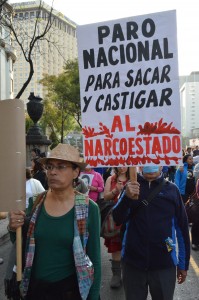 And he issued the invitation that would be repeated throughout the demonstration: “We will be waiting for you on February 5 to open discussion and attempt to forge national unity of Mexicans on a common agenda that will allow us once and for all to transform this country, against these corrupt institutions that are useless and do nothing to help our people. ”
And he issued the invitation that would be repeated throughout the demonstration: “We will be waiting for you on February 5 to open discussion and attempt to forge national unity of Mexicans on a common agenda that will allow us once and for all to transform this country, against these corrupt institutions that are useless and do nothing to help our people. ”
The MC also said that to vote in the state of Guerrero is to vote for organized crime, referring to the mid-term elections in June. “And there will not be elections, even though the little governor and the Interior Minister assure that there will be.” He added that, based on Art. 39 of the Constitution, in this state the people will govern by choosing popular assemblies.
Other voices heavy with grief echoed in the historic square. Epifanio Álvarez, another father of one of the 43, said:
“We left our homes, our crops because we are humble peasants, but with a lot of heart and courage. We have suffered so much, but we’re not tired, we’ll keep fighting. A child cannot be forgotten, like the president said that time about it being time to get over it. We will fight to the end, with the support of you who feel what we are going through. Sometimes at two o’clock in the morning we remember and we start to cry. With your support we will continue without stopping. ”
The Zócalo shouted in unison, ‘You are not alone! Peña Out!
The father of Alexander Mora Venancio stated that he will continue to demand the safe return of his son because “two months and ten days after the disappearance in Iguala, they told me he was killed on December 5th and one month and 45 days later I haven’t seen anything that they were going to give me of his remains … ”
He finished, “This damned gossiping government is no good for us Mexicans; all it does is to pressure grassroots organizations. It wants to threaten us, but we are not afraid.”
Another parent read a declaration of the Ayotzinapa school community and the National People’s Assembly that presents a disturbing picture of Guerrero and other regions of the country. Organized crime still leaves a trail of death among the population. Whole territories are controlled by criminal gangs under the complacent gaze of authorities of all levels. Crime has become entrenched in the government structure. The criminal heads of drug trafficking routes have been installed in government. The institutions responsible for providing security are extorting, disappearing and killing innocent people.
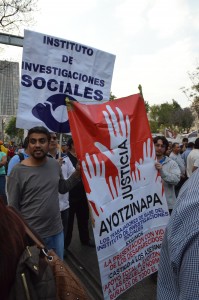 The diagnosis is raw: governments, clergy, political parties are accomplices of crime. Nobody has done anything to put an end to this situation. The form of politics based on handing out illicit money has allowed crime to become embedded in political parties, which then become murderers of the people.
The diagnosis is raw: governments, clergy, political parties are accomplices of crime. Nobody has done anything to put an end to this situation. The form of politics based on handing out illicit money has allowed crime to become embedded in political parties, which then become murderers of the people.
The neoliberal policies that the government has dogmatically adopted, the document continues, impoverish the majority and enrich a few oligarchs. Extractive companies blatantly steal the natural resources of farmers and indigenous peoples, taking their territories without consultation and with government complicity.
This government is a lackey to multilateral financial institutions and has privatized the countryside, petroleum, education, health and other services to benefit private capital. For the students, privatization is theft of public property and looting of natural resources, and the disappearance of the 43 students are part of the same criminal policy.
In the case of Ayotzinapa, the government faces its own disgrace, accummulated over the course of several presidential administrations full of lies and policies contrary to the interests of the majority of the population.
“Don’t take my word for it,” said Bardo Flores, another father who spoke at the rally. “It’s what experts from the National University say, that the version of events presented by Murillo Karam (Federal Attorney General) is not credible. He forgot that although we are farmers, although we are workers, low-income people, we are also thinking beings and we will not be deceived.”
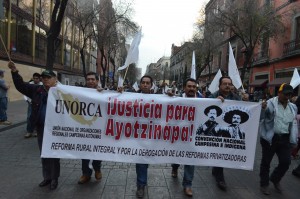 “As long as there is no scientific evidence to the contrary, for us our children are alive and we want them to search for them, because we parents are sure that the government has them, because from the beginning the government hasn’t looked for them–it has just put on a show in the hills, on the highways. ”
“As long as there is no scientific evidence to the contrary, for us our children are alive and we want them to search for them, because we parents are sure that the government has them, because from the beginning the government hasn’t looked for them–it has just put on a show in the hills, on the highways. ”
“The government was wrong. It thought it could repress us by filling up the state of Guerrero with soldiers and riot police we would back down. But we say we’re going to keep going, no matter the consequences, and as a teacher said yesterday, if necessary like trees die standing tall, we will do that for our children,” concluded Flores.
Hilda Hernandez, a mother, expressed her anger with the government. “We’re not going to stand there with our arms crossed after what they did to our children, they have to appear; the policemen took them. They were taken away by federal agents, military personnel were involved, and here there is nothing but to search among them, there’s no one else, no drug traffickers or anything, because here the traffickers are the government.” The response of the crowd was immediate: “It was the state! It was the state!”
Carmelita Cruz, mother of a missing student, agreed. “They were in uniforms, the ones who took them away, people sent by the high command. And Enrique Peña Nieto shouldn’t play dumb–if he doesn’t have them, he knows where they are. The military assassins, they participated directly; the 27th Battalion participated in Iguala in taking our children. And so we want them to deliver them, wherever they have them…”
The voices against the federal army formed a chorus, demanding that the investigations include the armed forces.
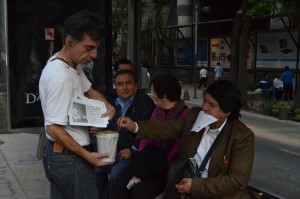 “The parents are confident that the government has our children because they told us how they had been threatened at the Huitzuco intersection by soldiers of the 27th Infantry Battalion of Iguala. They put guns to their heads, they kicked them and made them get on the bus when they were going to ask for donations weeks before being gunned down and disappeared,” said the last parent to use the microphone.
“The parents are confident that the government has our children because they told us how they had been threatened at the Huitzuco intersection by soldiers of the 27th Infantry Battalion of Iguala. They put guns to their heads, they kicked them and made them get on the bus when they were going to ask for donations weeks before being gunned down and disappeared,” said the last parent to use the microphone.
He added, “The government is the one that turns people into dust because no drug trafficker does that; they dismember and burn people, but they don’t turn them into a pile of ashes. We’ve always found remains or burned pieces in graves but we are sure that the government is the one that disappears people altogether. It can do that; the narcos can’t. ”
The next day, the Attorney General rushed to close the case, presenting the official version as “historical truth”, namely that the crime is confined to the local level, that the missing students were delivered by municipal police to a cartel in the region which killed and incinerated them in the Cocula dump, and threw their ashes into the river, which is why it is no longer possible to find their remains.
The Pro Center, a human rights organization, released a statement of the fathers and mothers called “Ten reasons not to close the Ayotzinapa case “, which states that there is no full scientific certainty regarding what happened at the Cocula dump, that the formal hypothesis relies heavily on statements that may have been induced, that the state has failed to arrest Iguala police chief Felipe Flores Velázquez and 11 other fugitives, that the Attorney General’s office has not filed a single charge of forced disappearance (the relevant legal figure), that the role of the military has not been clarifed, among other things.
Meanwhile, the Ayotzinapa movement has propelled the construction of a new national consciousness, weaving the unity of many sectors dissatisfied with the neoliberal model. They see this as an opportunity to forge together a democratic and popular outlet to transform the system political Mexican, plagued by the worst crisis of the last half century.
Alfredo Acedo is communications director and advisor to the UNORCA and member of the Americas Program www.americas.org/es.



